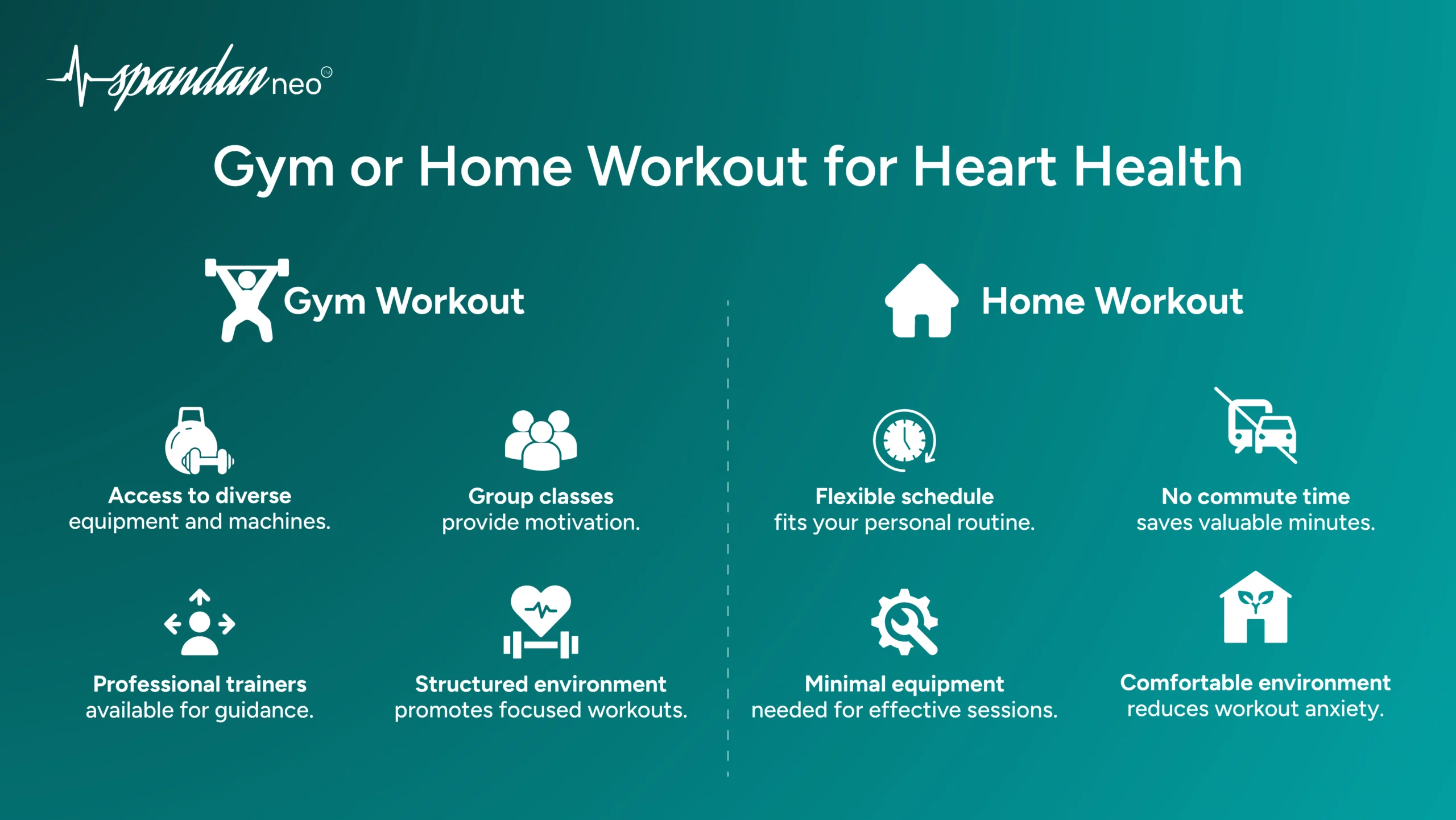
Gym or Home Workout for Heart Health
Table of Contents
Confused about whether you should opt for a Gym or Home Workout? We all know that exercise can feel like a burden at times. Whether you’re trying to find the motivation to hit the gym or stay consistent with home workouts, it’s essential to choose an option that suits your lifestyle and personality.
Are you an extrovert who thrives in social settings, or an introvert who prefers the comfort of home? In this blog, we’ll explore the benefits and challenges of gym or home workout settings, helping you make an informed decision that keeps your heart active and healthy. Let’s find the right fit for your fitness journey!
Why Workout is Crucial for Heart Health
Whether it is a gym or home workout they both aim towards better heart health and overall strengthening of our body. There are various reasons why exercise is important for heart health. The heart muscles are strengthened, which improves the heart’s ability to pump blood.
This results in better circulation, which supports overall organ function by assisting in the delivery of nutrients and oxygen as well as the removal of waste. By increasing blood vessel elasticity and lessening the burden on the cardiovascular system, regular exercise can help lower blood pressure.
Workout also contributes to cholesterol balance by raising good HDL cholesterol, which is essential for heart health, and decreasing bad LDL cholesterol. It helps reduce body weight, which is important in lowering the risk of heart disease.
Gym or Home Workout Options
Both gym or home workout can be effective for improving heart health, depending on your preferences and lifestyle. Here are some options for each:
Gym Workouts for your heart
1.Treadmill Running/Walking: As an adjustable cardio training platform, treadmills let users customize their workouts by adjusting the speed and incline to suit their fitness level. Beginners can increase their endurance by starting with a quick walk, while more experienced users can increase their intensity by adding running intervals. By changing the incline, you can do hill training, which burns more calories and works various muscle regions.
2.Stationary Cycling: One excellent low-impact cardio alternative that can be adjusted to suit different levels of fitness is stationary cycling. Cycling can be done at a gradual pace or at a fast pace. Maintaining proper posture and adjusting the resistance to keep your muscles working are key to getting the most out of your cycling session. To keep track of your advancement over time, you can also measure your speed and distance.
3.Rowing Machine:Your legs, core, and upper body are among the many muscle groups that the rowing machine works out. It’s an effective method of strengthening muscles and elevating your heart health at the same time. It’s important to use proper form.
4.Group Classes:Taking part in group fitness programs can infuse your exercise regimen with motivation and pleasure. Exercises like kickboxing, Zumba, and spinning offer a vibrant environment where you can push yourself and others. Each class typically offers a different focus, whether it’s high-energy dance moves in Zumba or intense cardio and strength intervals in kickboxing. Experimenting with various classes can keep your routine fresh and engaging.
5.Elliptical Trainer:The elliptical trainer is a popular choice for individuals seeking a gentle aerobic exercise with minimal impact on the joints. It resembles running or walking but has a lower impact because of its smoother quality. Many elliptical machines come equipped with handlebars that allow you to also engage your upper body.
Home Workouts for your heart
1. Jump Rope: Start with short sessions and focus on proper technique. Increase the duration gradually as your endurance improves, leading to better cardiovascular fitness and coordination. In order to avoid tripping, utilize a light rope and ensure the area is level.
2.Bodyweight Exercises: Design a workout routine involving push-ups, squats, lunges, and planks. Perform the circuit 2-4 times. Enhances muscle strength and increases heart rate. Pay attention to proper form for optimal results and reduced chances of injury.
3.Dance Workouts:Join in online classes or dance to your favorite songs for at least 30 minutes. It’s a fun way to do cardio, enhance coordination, and uplift your mood. Incorporate both fast-paced and slower songs for interval training.
4.Stair Climbing:Utilize the staircases within your household or at a park located nearby. Try walking or running up stairs at a consistent speed for leg strength and better endurance. Add stair climbing to your daily habits, such as using stairs instead of the elevator.
Gym or Home Workout: Which Is Better?
When it comes to fitness, the choice between gym or home workout often sparks debate. Each option has its unique benefits and drawbacks, and the best choice ultimately depends on individual preferences, goals, and circumstances. Here’s a detailed comparison to help you decide which is better for you.
1.Accessibility and Convenience
A) Home Workouts:
- Pros: Since there is no commute time involved, working out from home allows you more schedule flexibility. You can work out at any time of day that works for your schedule, including late at night or early in the morning.
- Cons: Distractions at home may make it more difficult for you to concentrate when working out.
B) Gym Workouts:
- Pros: Many amenities and equipment are provided in gyms, giving access to resources that might not be available at home. This may inspire you to attempt different exercises.
- Cons: Gyms may have limited hours and a membership price, which might not work with your schedule.
2.Equipment and Space
A) Home Workouts:
- Pros: A yoga mat, resistance bands, and dumbbells are some of the basic equipment you can use to customize your exercise area. Bodyweight exercises are an excellent way to improve your heart health.
- Cons: Your options for exercise may be limited by a lack of equipment and space.
B) Gym Workouts:
- Pros: A variety of machines and free weights are usually available in gyms, so you can simply modify your program and target different muscle areas.
- Cons: In crowded gyms, you may have to wait for equipment, which might disrupt your training routine.
3.Social Interaction and Motivation
A) Home Workouts:
- Pros: Some folks like the isolated atmosphere of working out from home. You are free from social pressure to concentrate just on your routine.
- Cons: For some people, the absence of social interaction might result in feelings of loneliness or decreased motivation.
B) Gym Workouts:
- Pros: Meeting new people, and peer support, gyms also promote a sense of community. Classes in groups can be especially motivating.
- Cons: In a gym, some people could feel nervous particularly if they’re now to it.
4.Cost Considerations
A) Home Workouts:
- Pros: Long-term working out from home can be more affordable because there are no membership fees and you can buy a few inexpensive pieces of equipment.
- Cons: Upfront costs for equipment can be a barrier, and the temptation to buy unnecessary gadgets can add up.
B) Gym Workouts:
- Pros: Several gyms provide classes, personal training, and modern equipment for a cost, which can be advantageous for people who enjoy supervised exercise.
- Cons:Monthly memberships may come with a high price tag, and certain gyms could charge extra for guidance.
In conclusion, whether you choose a gym or home workout, both options offer valuable benefits for enhancing your heart health and overall fitness. It’s essential to consider your personal preferences, lifestyle, and goals when making this decision. By evaluating the accessibility, equipment, social interaction, and cost considerations of gym or home workouts, you can find the perfect fit that keeps you motivated and engaged in your fitness journey. Remember, the best workout is the one that you enjoy and can stick with!















